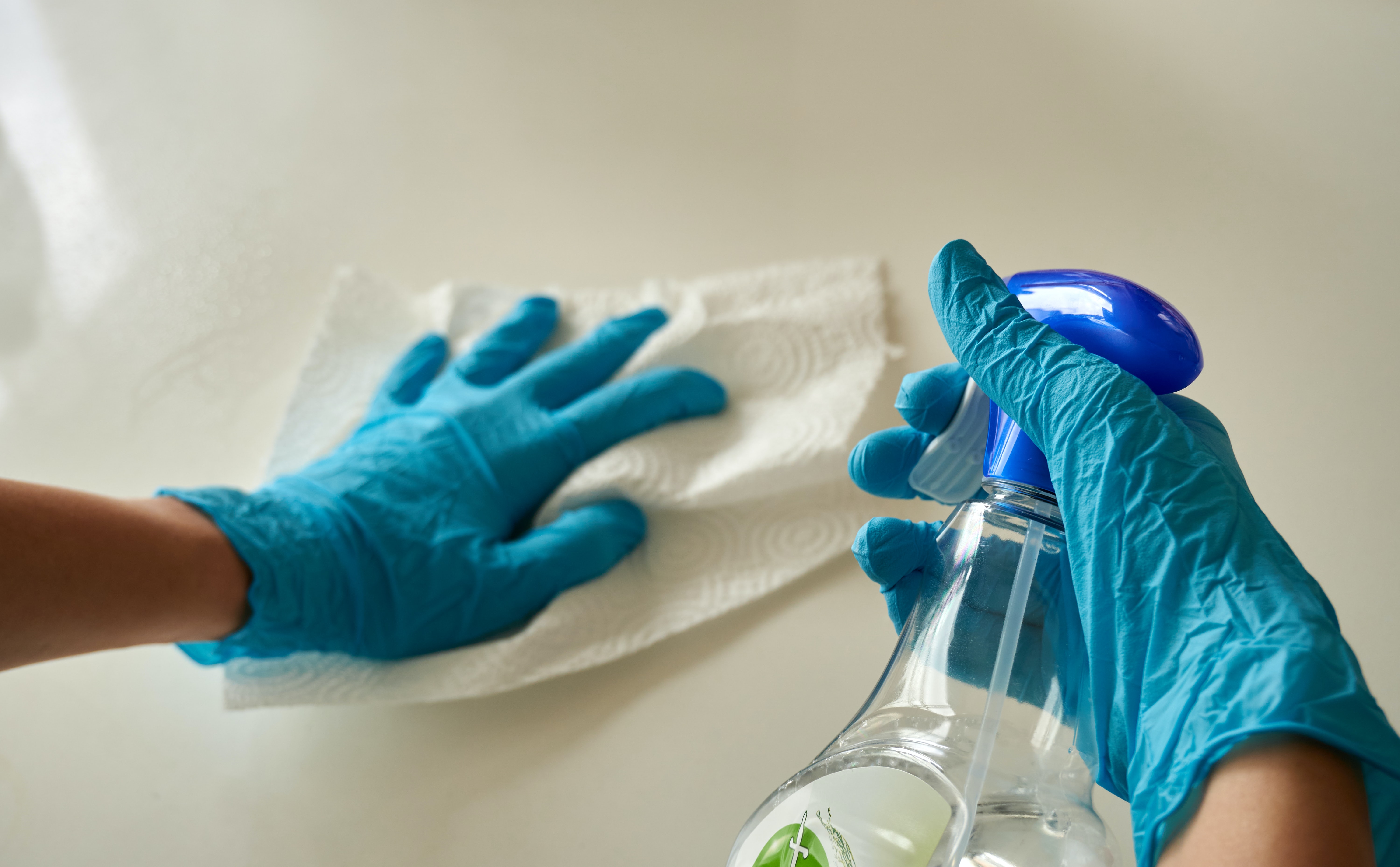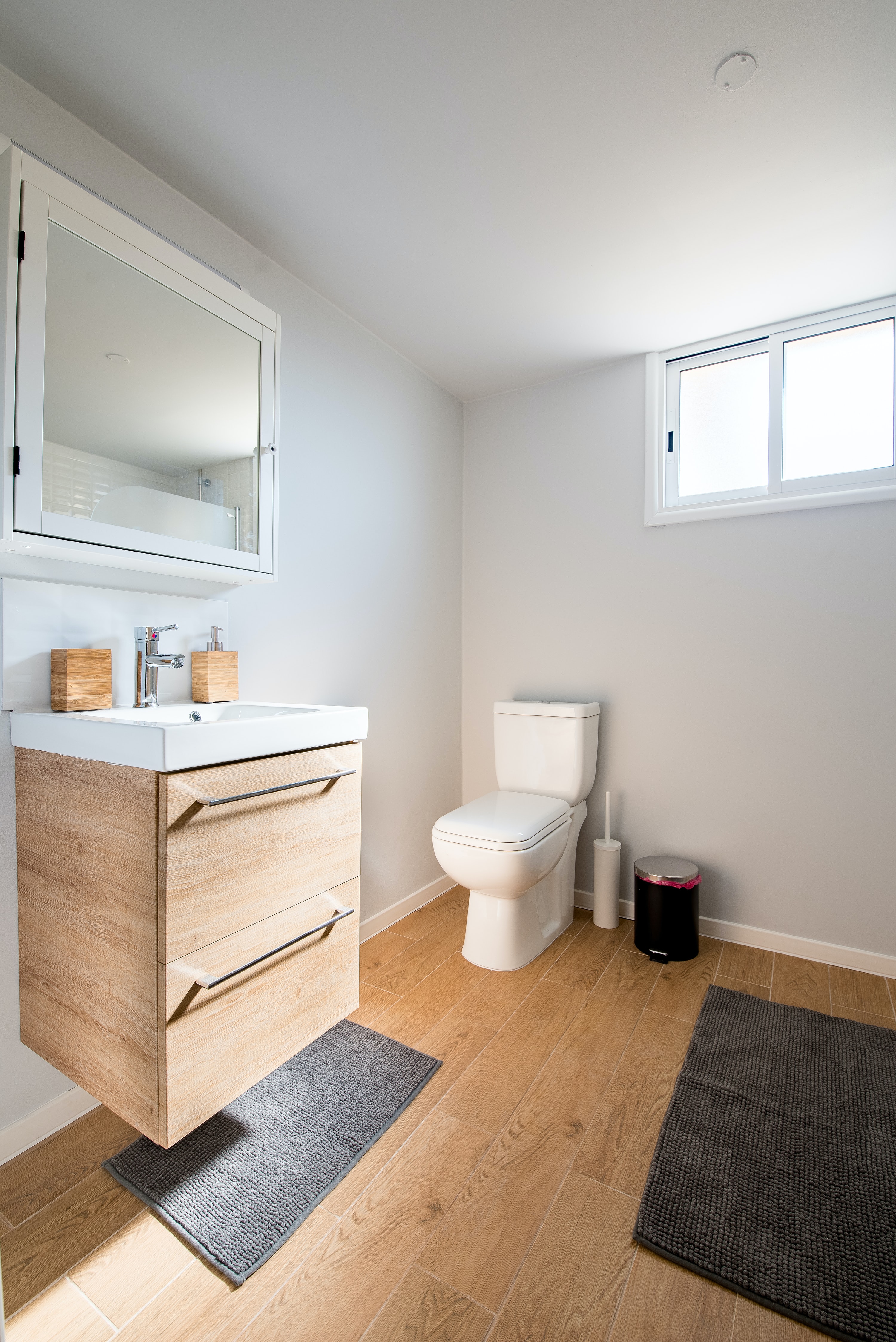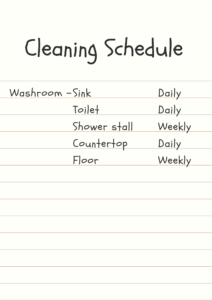The post How To Keep Your Bathroom Floor Dry appeared first on Like Ah Trini.
]]>Growing up in Trinidad in the 1980s, things were a bit different back then. Our family shower was in an enclosure outdoors with a wooden pallet on concrete that quickly dried in the sunshine. Now, our homes have evolved and we mostly have slick tiled surfaces in indoor bathrooms.
Not only can a wet bathroom lead to slipping accidents, but it can also be a breeding ground for mould and mildew which has been shown to cause adverse health effects such as asthma. Paying attention to this is especially important for the safety and well-being of our children or older family members.
Here are ten tips you can implement to help keep your bathroom floor dry and maintain a clean safe space.
1. Use Bathroom Floor Mats and Rugs
Bathroom rugs and mats are a convenient solution for maintaining a dry bathroom floor. Some of the common rugs on the market are made from highly absorbent microfiber material that can quickly soak up water and help to keep the floor dry. Ensure that it has non-slip backing which will keep it stable and prevent them from sliding.
Sourcing rugs that are durable yet machine washable is a must to keep them clean and hygienic and can withstand regular use. There are many available in various colours and sizes to match your decor and space.
2. Install a Shower Curtain
If your shower has an enclosure with a door, then the obvious solution is to close the door when showering to avoid water splashing outside of the enclosure.
If, however, this is not an option the next best alternative is to install a shower curtain. A shower curtain can not only be a beautiful accessory to add to the aesthetic of the bathroom, but they play a considerable role in keeping the water contained in the shower area.
When searching for a shower curtain, ensure that it is waterproof or water-repellant to prevent water from soaking through. Easy to install and remove as well as easy to clean and maintain. Also, make sure that the size is appropriate for your shower area.
Make sure to keep the shower curtain closed during showers to prevent water from splashing onto the floor.
3. Keep Bath Towels Nearby
Try to place your towels as near as possible to the shower or bath for easy access. This allows you to dry off quickly after the shower without having to walk a distance to get the towel, leaving a trail of water behind you. Not to mention that this helps to save time and can get you feeling warm sooner as stepping out of the shower can leave you feeling cold.
4. Dry Off in The Shower
Especially with young children who may be anxious to run out of the bath, taking a few minutes to remove as much water off the body as possible before stepping out of the shower will certainly help to keep the bathroom floor dry. This simple practice not only minimizes water drips and trails, but also instils good habits in children regarding bathroom cleanliness and safety. Teaching them about the potential hazards of a wet floor and the importance of drying off can go a long way in creating a hygienic and accident-free bathroom environment. And, as mentioned before, keeping the towel nearby will make this whole process easier, ensuring a smooth transition from bath time to dry floors.
5. Use a Shower Caddy
Use a shower caddy to store your shampoo, conditioner, shower gels, and other bathroom essentials making them easily accessible. This not only helps you avoid stepping out of the shower if you’ve forgotten a product, but also prevents water from pooling up under the bottles if on the floor.
Stainless steel caddies tend to be durable and resistant to rust, which are suitable for the humid bathroom environment. They also prevent the growth of mould and mildew and are also easy to clean and maintain.
6. Squeegee Shower Doors
Particularly if your shower stall is made out of glass or acrylic it is a good idea to invest in a squeegee and incorporate the habit of using it to quickly remove excess water after each shower. This simple practice can yield significant benefits, especially when it comes to maintaining a dry bathroom floor.
Shower stalls with glass or acrylic doors can be prone to water spots and droplets after showers. These water remnants, if left unattended, can easily end up on the bathroom floor when the door is opened, contributing to unwanted wetness. By keeping a squeegee handy and dedicating a mere few seconds to swipe the water off the door and walls, you not only prevent water from spilling onto the floor but also eliminate the potential for water stains and residue buildup on your shower surfaces.
When selecting a squeegee, opt for one with a comfortable grip and a high-quality rubber blade that efficiently clears the water. Keep it within arm’s reach in the shower for easy access.
7. Use a Shower Splash Guard
A shower splash guard is a smart and practical solution to tackle the issue of water spilling in your bathroom. These simple accessories act as a barrier, stopping water from escaping your shower or bathtub onto your bathroom floor.
Splash guards are designed to work with your shower curtain, keeping it snug against the shower walls. This prevents splashes and spills, ensuring water stays where it should and avoiding wet floors. They’re versatile too, fitting both showers and bathtubs and made from waterproof materials to withstand water exposure. Installing them is easy, as many models have simple setups.
Cleaning them is a breeze as well– a quick wipe or rinse keeps them in good shape. These guards team up with your shower curtain to prevent leaks and add tidiness to your bathroom. So, if you want an easy way to keep water where it belongs, consider adding a shower splash guard to your bathroom setup.
8. Keep the Bathroom Well-Ventilated
Keeping the bathroom well-ventilated is crucial to dissipating moisture and maintaining a dry bathroom floor. Also, proper ventilation helps to avoid water damage and build-up of mould and mildew that thrive in a damp environment. It will help to improve the air quality and remove unpleasant odours.
If your bathroom has an exhaust fan, turn it on during and after showers or baths. Allow it to run for a few minutes after showering to draw out moist air. Some exhaust fans come with a sensor that automatically switches them on or off depending on the humidity level.
If you have windows, open them to allow fresh air to circulate and assist in dissipating moisture.
9. Use A Dehumidifier
In bathrooms with poor ventilation, a dehumidifier can be an option to decrease moisture and keep the floor and other surfaces dry.
In a nutshell, a dehumidifier works by drawing moist air into it through a vent and passing this air over cold coils. This causes the water in the air to condense and drip down into a catchment container. The dry air is then reheated and released back into the air.
They are usually easy to operate and can be quiet and energy-efficient. Always consider the size of the space in which it is to be used before purchasing a dehumidifier.
10. Keep The Bathroom Clean
I always admired my dad’s penchant for keeping an immaculate bathroom; he was an absolute boss at keeping surfaces dry after use. This is definitely one habit that can help to remove excess water and moisture in the bathroom.
Regularly clean and wipe down bathroom surfaces and dry any wet spots on the floor promptly. This will also help to keep the bathroom clean and hygienic. An absorbent mop can be used or floor towels which can later be added to the wash for easy cleanup. If using ordinary towels, it is best to keep towels for cleaning the bathroom separate from towels to dry the body.
In conclusion, maintaining a dry bathroom floor isn’t just about aesthetics; it’s about creating a safe, comfortable, and hygienic space for everyone in the household. From using absorbent mats and shower curtains to incorporating simple habits like squeegeeing and proper ventilation, these practical tips can make a substantial difference in preventing water-related accidents and maintaining the overall cleanliness of your bathroom.
Remember, it’s the small, consistent efforts that often yield the most significant results. By following these strategies, you’re not only enhancing the functionality and safety of your bathroom but also ensuring a more pleasant and worry-free experience for you and your loved ones. So, let’s embrace these practices and step onto dry, comfortable bathroom floors every day!
What are your favourite tips for keeping your bathroom clean and dry? Let us know in the comments.
The post How To Keep Your Bathroom Floor Dry appeared first on Like Ah Trini.
]]>The post How To Create A Cleaning Schedule appeared first on Like Ah Trini.
]]>Every Saturday morning, my grandparents would be up bright and early. By 6 am Pappy, dressed in his yard clothes was outside cutting grass with a cutlass while Granny was cooking stewed chicken and rice for lunch – some of that delicious stew we would have with hot homemade bread for breakfast. After, breakfast and washing up, it was time for the weekly chores.
The windows and curtains were opened to invite in the fresh morning air and brilliant sunbeams. The minute we opened the eastern bedroom windows there were the neighbours, the two kindly older ladies that lived next to us, ‘sending right’ (waving) with the usual courtesies, “Mawnin neighbs!”. One was sweeping their upstairs gallery and the other was out by the front lawn tending to their gorgeous, well-kept rose garden.
Across the road, uncle Robert was just starting up his lawn mower and the air already smelled of freshly cut grass. Everybody was up and about!
There was so much vibrant energy around and everyone in the neighbourhood was doing their part. Ah, the good old days!

Although Saturdays saw the family coming together to do the majority of the deep cleaning, my grandparents both had daily cleaning and tidying rituals built into their routines that helped to keep the home orderly and visitor-ready. I always admired this.
Unfortunately, by the time I was old enough to really appreciate the amount of care and consideration that went into their love of taking care of the home, they were both well into the autumn of their years. I would have loved to learn much more from them.
I have fond memories of cleaning with my grandparents growing up as a very young child. Helping Granny ‘dust the chairs’ and helping Pappy sweep up the guava leaves in the yard with a cocoyea broom.
Life has changed so much since then!
Now we live in a fast world – fast food, fast entertainment, emails, social media, and just well…. busyness! Along the way we have lost track of so many aspects of ourselves, our homes are being neglected, our diets have changed from nutritious wholesome food to convenience foods laden with chemicals, exercise is a trip from the bedroom to the kitchen (hardly anyone even walks to the mailbox anymore) and on and on.
Not to mention, we moms have lots on our plates, taking care of our children and families, and some of us working to bring in an income as well. It can all be so exhausting. How can we get it all done?
The truth is we can’t do everything, but we can prioritise and do what is important – little by little, step by step and we will get there.
One aspect that I know a lot of moms struggle with is keeping the home clean.
The Importance of A Clean Environment
Jordan Peterson, Canadian psychologist, professor and author of 12 Rules For Life, An Antidote to Chaos, one of his biggest pieces of advice for an improved sense of mental well-being, is to ‘clean your room’. How true this is!
Our environment is an extension of ourselves and it affects our energy on multiple levels. In my own experience, a cluttered room or a sink overflowing with dirty dishes causes me anxiety.
Studies done over the years have shown that living in a cluttered, dirty and disorganized environment can lead to depression, fatigue, lack of focus and a decline in health.
Especially now in the times in which we live, where hygiene and cleanliness are emphasized to prevent the spreading of harmful germs, viruses and bacteria, it is important to keep our homes clean. It also helps to prevent vermin such as rats and cockroaches who may be looking for the perfect environment to raise their families.
Out of so many other factors in life that we may have little control over, the cleanliness of our home is one thing that we can control.
So how do we make progress toward a more organized, tidier home without feeling overwhelmed? Follow a cleaning schedule.
What is a Cleaning Schedule and Why Should You Have One?
A cleaning schedule is a written plan to accomplish cleaning tasks that need to be completed to achieve a level of cleanliness.
It is beneficial to have a cleaning schedule to:
- Reduce stress associated with cleaning
- Organize tasks by frequency – daily, weekly, monthly, seasonally etc.
- Eliminate decision fatigue and confusion
- Maintain order around the home
- Make tasks quick and efficient if you know what comes next and what it entails
- Get family on board where everyone knows their duty
The main key to creating a cleaning schedule is to make it realistic for you and your family.
How to Create A Cleaning Schedule
Divide Each Room into Areas or Components
The first step is to identify the individual rooms/spaces that need to be cleaned and maintained.
Start with your first room, let’s use the washroom as an example. Do a walk-through of the area and also take a picture to examine the different components of the room that require cleaning.
The washroom could be divided into the shower stall, toilet, sink, countertop, mirror and floor depending on your layout. Identify then write down each area to be cleaned.

Determine How Often Each Part Needs to Be Cleaned – Frequency
For example, the shower stall and mirror could be cleaned once a week, while the toilet, sink and counter may need daily cleaning.
Your initial list may look something like this:

Create A Master List of Tasks
Here is a simple template that you can use to get you started creating your schedule.
Make your master list detailing all the tasks that need to be carried out in each room, and how often they should be done to achieve a standard of cleanliness.
Assign Days and Times To Family Members to Complete Tasks
If you have family members who can and are willing to assist and do their part in keeping the home tidy, communicate with them about the new cleaning schedule and assign tasks to them to help with the upkeep of the home. As well, if you are single or a single parent with young children, space out the chores in a way that is suitable and realistic to you to avoid burnout and overwhelm. We’re just doing our best out here.

Make a note of the assigned tasks and post it somewhere in the home that everyone has access to see who has what chores/tasks to do on which day.
Make a List of Cleaning Supplies and Tools that Will be Needed
Different areas of the home may require different cleaning agents and tools. Make a list of the items you would need to get the job done. Mop, broom, dustpan, buckets, sponges, all-purpose cleaner, cleaning cloths, dishwashing liquid, disinfectant etc. You don’t have to go on a shopping spree but just ensure that you have the basics on hand.
Create Index Card System
I have found that the Index Card system is a very valuable part of the cleaning scheduling process.
Essentially, this is where the daily tasks for each room are written on an index card and placed somewhere safe in the room to be cleaned. These tasks are more of a quick spruce up and not a deep clean and should fit into a fifteen-minute time block.
Anytime I am ready to do a quick 15-minute clean in the bathroom, for example, I grab my supplies, the index card telling me exactly what needs to be done, I set my timer and go for it! By the time, I’m done the bathroom is sparkling! For me, trying to beat the timer adds to the motivation to get it finished!
Get an index card for each room and write the daily tasks for that room on it. Place it in an area of the room where it would be safe and dry, such as in a drawer or pinned to a pegboard but where you would have easy access to it. When it is time to clean, gather your cleaning tools, set a timer for 15 minutes and see if you can complete the daily tasks within the time.
Every time you need to clean a particular room, your checklist is always handy on an index card nearby. No hassle, no worries, just follow what’s on the card!
Try Out Your New Cleaning Schedule and Improve as You Go Along
Now it’s time to implement the cleaning schedule. Bring the family on board and test it out for a week. Some family members may want to switch up tasks or offer suggestions to get things done more efficiently.
You yourself may realize that some tasks should be done before others and the order should be changed. For example, you may find that you can put the toilet bowl cleaner in the toilet first and let it work while you clean the sink and the countertop in the washroom.
Most of all have fun with it!
Here are a few tips to make cleaning easier and more pleasant:
- Listen to your favourite music while you clean –, jazz, soca, techno, pop – whatever gets your energy up. Also, you can press play on your favourite audiobook or podcast.
- Put your favourite essential oil in a diffuser or light some incense, or use the old-fashioned way of boiling cinnamon and orange peel on the stove.
- Use a timer – make it fun among family members to complete their chores before time runs out.
- Use a caddy to carry around your cleaning tools and also place cleaning items in areas where they can be easily accessed to avoid delays when running from one room to another. For example, store the multipurpose cleaner for the bathroom under the bathroom sink rather than in the kitchen.
- Do two-minute tasks – on days when you feel overwhelmed or can’t find time to get everything done, simply do small two-minute tasks to help move the needle. Little by little you will get there.
Forget about perfection!
Just do your best. If you missed a spot today, you will get it tomorrow.
Keep at it and eventually, you will memorize the steps to clean a room and it becomes a habit. Next thing you know, much of the stress is gone and keeping a (mostly) tidy home is part of the norm.
What about you? Do you have any cleaning and tidying tips to share?
The post How To Create A Cleaning Schedule appeared first on Like Ah Trini.
]]>







